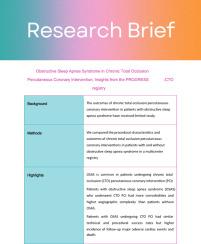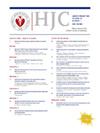Obstructive sleep apnea syndrome in chronic total occlusion percutaneous coronary intervention; insights from the PROGRESS-CTO registry
IF 3
3区 医学
Q2 CARDIAC & CARDIOVASCULAR SYSTEMS
引用次数: 0
Abstract
Objective
To examine the outcomes of chronic total occlusion (CTO) percutaneous coronary intervention (PCI) in patients with obstructive sleep apnea syndrome (OSAS).
Methods
We compared the procedural characteristics and outcomes of CTO PCIs in patients with and without OSAS in a multicenter registry.
Results
Of 7403 patients who underwent 7408 CTO PCIs between 2012 and 2024 at 47 centers, 942 (13%) had OSAS. Compared with patients without OSAS, patients with OSAS were older; more likely to be men; and had higher prevalence of diabetes, hypertension, dyslipidemia, cerebrovascular disease, previous heart failure, coronary artery bypass graft surgery, and prior PCI. They had higher J-CTO (2.73 ± 1.20 vs. 2.30 ± 1.25; p < 0.001) and PROGRESS-CTO (1.35 ± 1.01 vs. 1.16 ± 0.96; p < 0.001) scores, longer lesion length, and more complex angiographic characteristics. Compared with patients without OSAS, OSAS patients had similar technical success (87.6% vs. 88.3%, p = 0.552) and procedural success (85.9% vs. 87.2%, p = 0.260). There were no differences in terms of in hospital MACEs and death. After a median follow-up of 71 days, the incidence of MACEs (3.9% vs. 1.6%, p = 0.026) and death (2.6% vs. 0.6%, p = 0.003) was higher in patients with OSAS. In multivariable analysis, OSAS was independently associated with higher follow-up MACEs (hazard ratio 2.32, 95% confidence intervals 1.22–3.26, p = 0.006).
Conclusion
OSAS is common in patients undergoing CTO PCI. Compared with patients without OSAS, OSAS patients had more comorbidities and more complex CTOs, similar rates of periprocedural success and complications, and higher incidence of follow-up MACEs.

慢性全闭塞经皮冠状动脉介入治疗中的阻塞性睡眠呼吸暂停综合征来自PROGRESS-CTO注册表的见解。
背景:慢性全闭塞(CTO)经皮冠状动脉介入治疗(PCI)对阻塞性睡眠呼吸暂停综合征(OSAS)患者的疗效研究有限。方法:我们在多中心注册中比较了伴有和不伴有OSAS患者的CTO pci的程序特征和结果。结果:在2012年至2024年间,在47个中心接受了7408例CTO pci的7403例患者中,942例(13%)发生了OSAS。与非OSAS患者相比,OSAS患者年龄较大;更有可能是男性;糖尿病、高血压、血脂异常、脑血管疾病、既往心力衰竭、冠状动脉搭桥手术和既往PCI的患病率较高。J-CTO增高(2.73±1.20 vs. 2.30±1.25);结论:OSAS在CTO PCI患者中很常见。与非OSAS患者相比,OSAS患者有更多的合并症和更复杂的cto,术中成功率和并发症率相似,随访mace率更高。
本文章由计算机程序翻译,如有差异,请以英文原文为准。
求助全文
约1分钟内获得全文
求助全文
来源期刊

Hellenic Journal of Cardiology
CARDIAC & CARDIOVASCULAR SYSTEMS-
CiteScore
4.90
自引率
7.30%
发文量
86
审稿时长
56 days
期刊介绍:
The Hellenic Journal of Cardiology (International Edition, ISSN 1109-9666) is the official journal of the Hellenic Society of Cardiology and aims to publish high-quality articles on all aspects of cardiovascular medicine. A primary goal is to publish in each issue a number of original articles related to clinical and basic research. Many of these will be accompanied by invited editorial comments.
Hot topics, such as molecular cardiology, and innovative cardiac imaging and electrophysiological mapping techniques, will appear frequently in the journal in the form of invited expert articles or special reports. The Editorial Committee also attaches great importance to subjects related to continuing medical education, the implementation of guidelines and cost effectiveness in cardiology.
 求助内容:
求助内容: 应助结果提醒方式:
应助结果提醒方式:


